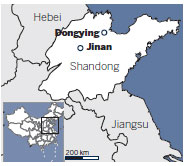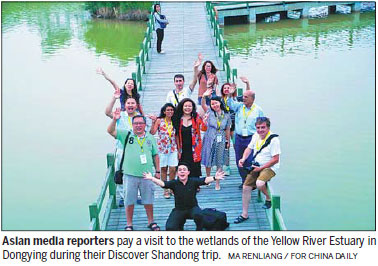Dongying represents best of Shandong during Astana Expo
City aims to illustrate its rich natural resources, industrial might and magnificent scenery
Dongying, where China's second-largest oilfield Shengli Oilfield is located, is expected to steal the limelight of the Expo 2017 Astana on Sept 8.
The powerhouse in East China's Shandong province is due to stage a Dongying Day during the third day of the Shandong Week running from Sept 6-8.
Li Huifen, chairwoman of the Dongying committee of the China Council for the Promotion of International Trade, told China Daily that the city is now in high gear to prepare the Dongying Day during the expo themed as "Future energy".
During the day, city officials and company representatives will take part in the event. A promotion fair will be held to display the city's advantages and investment opportunities, she said.

Dongying is rich in natural resources and has about 26.67 million hectares of unused land.
As the region with the largest reserve land in eastern China, Dongying has great development potential, Li said while explaining why it was chosen to hold the city day event.
The coastline stretches 413 kilometers, and the coastal intertidal zone spans 12 million hectares.
Dongying is one of the key oil production bases in China. As Shengli Oilfield's main production base, the city produces 85 percent of the entire oilfield's yield and reserves 80 percent of the area's petroleum, according to the chairwoman.
Dongying has built several major industrial clusters in the fields of petroleum chemicals, salt chemicals and petroleum equipment, as well as rubber tires, auto parts and nonferrous metals.
The one-time crude oil processing capacity has reached 69 million tons, ranking first among other Chinese cities. The petroleum equipment industry is Dongying's specialty and a shining example of "Made in Shandong" and "Made in China".
The current number of oil equipment enterprises with their revenue above 20 million yuan ($2.95 million) for each in the city has reached 125, from which the main sector's business income reached 64.28 billion yuan in 2016.
Last year, the sector's export volume reached 326.5 million yuan.
The output of the petroleum equipment industry in the city accounted for a third of China's total, making the city the largest manufacturing base in China's petroleum equipment industry.
Since the Belt and Road Initiative was proposed, Dongying has continuously optimized its advantageous industries and opening-up.
In 2016, the total volume of Dongying's imports and exports was 99.59 billion yuan, an increase of 24.7 percent year-on-year.
The imports and exports volume with countries involved in the Belt & Road Initiative was 36.47 billion yuan in 2016, an increase of 12.1 percent year-on-year.
Locally specialized products such as petroleum equipment, rubber tires, fine chemicals, textiles, auto parts and agricultural products made up the bulk of trade with countries involved in the B&R, providing new growth points for foreign trade development in Dongying.
The city is located in northeastern Shandong province, in the delta where the Yellow River, China's mother river, joins the sea.
The delta's 8,243 square kilometers include Dongying, Hekou and Kenli districts as well as Guangrao and Lijin counties.
The area's permanent resident population totals 2.11 million.
Located in the central part of the Yellow River Delta, Dongying's eastern part is close to the Bohai Sea.
Its northern part neighbors Beijing, Tianjin and the Tangshan Economic Zone, while its southern part contains the Shandong Peninsula Blue Economic Zone.
It is a key node city in the Bohai Economic Rim and the coordinated development of Beijing, Tianjin and Hebei.
The city has the most complete, broadest and youngest wetland ecosystem in the Yellow River Delta National Nature Reserve in China. Known as "one of the most beautiful wetlands in China", it covers 1,530 square kilometers
yangcheng@chinadaily.com.cn


(China Daily 07/18/2017 page12)














